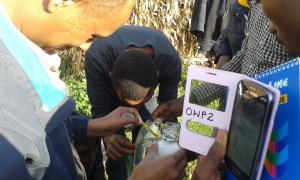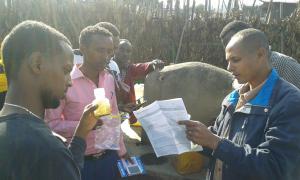In this blog on the UN-Water meeting that was held in Geneva last month, Joseph Pearce and Ton Schouten give an intriguing insight in the monitoring of the new sustainable development goal (SDG) for water. They argue that the SDGs, as they are now formulated, demand for strengthening national monitoring systems. "Not a bit in the coming years, but a lot and fast."
Published on: 20/02/2015
On 29 and 30 January 2015, the UN-Water Technical Advisory Unit organised the 1st Consultation of the Global Expanded Water Monitoring Initiative (GEMI) in Geneva. GEMI is led by several UN organisations and advocates for a water Sustainable Development Goal (SDG) that covers more than drinking water access and access to sanitation only. The big water goal, SDG 6, includes 6 targets. The first two are for drinking water and sanitation which are within the responsibility of the Joint Monitoring Programme (JMP). The remaining four concern treated wastewater, water quality and integrated water resources management (Box).
6.1 by 2030, achieve universal and equitable access to safe and affordable drinking water for all. 6.2 by 2030, achieve access to adequate and equitable sanitation and hygiene for all, and end open defecation, paying special attention to the needs of women and girls and those in vulnerable situations. 6.3 by 2030, improve water quality by reducing pollution, eliminating dumping and minimizing release of hazardous chemicals and materials, halving the proportion of untreated waste water, and increasing recycling and safe reuse by x% globally. 6.4 by 2030, substantially increase water-use efficiency across all sectors and ensure sustainable withdrawals and supply of freshwater to address water scarcity, and substantially reduce the number of people suffering from water scarcity. 6.5 by 2030, implement integrated water resources management at all levels, including through transboundary cooperation as appropriate. 6.6 by 2020, protect and restore water-related ecosystems, including mountains, forests, wetlands, rivers, aquifers and lakes (target date derived the Convention on Biological Diversity). |
The GEMI Geneva meeting aimed at reviewing the technical options for monitoring these ‘added’ targets; discussing the capacities of Member States to collect and process the data for the added targets; soliciting support from donor agencies and; engaging with countries willing to pilot monitoring of the ‘bigger’ water SDG in the coming months. The Geneva meeting was attended by senior representatives of Members States, donor agencies, UN agencies and technical experts.
 Actually it is fantastic to have a holistic water goal. Why having a target for access to drinking water and ignore the status of the water resource? Why having a target for access to sanitation without having a target for wastewater treatment? But adding targets also is adding a level of complexity to the monitoring of the targets. That was the general take of many participants in the GEMI meeting: great to have the bigger water goal but very complex to monitor the added targets.
Actually it is fantastic to have a holistic water goal. Why having a target for access to drinking water and ignore the status of the water resource? Why having a target for access to sanitation without having a target for wastewater treatment? But adding targets also is adding a level of complexity to the monitoring of the targets. That was the general take of many participants in the GEMI meeting: great to have the bigger water goal but very complex to monitor the added targets.
It was clear from the GEMI meeting that the Joint Monitoring Programme (JMP) is the shining and confident body for monitoring water and sanitation targets and ready to monitor the drinking water and sanitation targets of SDG 6. But it was not that straightforward 15 years ago.
It took quite some time to figure out how to monitor the drinking water and sanitation targets of the MDGs. Now the JMP of UNICEF/WHO is the solid processor of global data on drinking water and sanitation with all the essential steps in the process of data collection and use well laid out, roles and responsibilities defined and finance secured. The annual release of the “Progress on Drinking Water and Sanitation” updates of the JMP is a milestone for policy makers and sector specialists and the data have triggered debate and action.
The added targets will need to go through similar processes of seeking the best mechanisms to gather reliable data, sorting out roles and responsibilities for data collection and validation, securing the finance, establishing routine and respected reporting to gain the status and credibility of JMP reporting.
During the GEMI meeting Member States were caught between enthusiasm and doubts about the expansion of the Millennium Development Goals (MDGs) to a holistic Sustainable Development water Goal. Jordan, Morocco, Algeria, and Egypt expressed the need for making water stress visible and its impact on economic growth. In a world of increased water insecurity and conflicts over water uses, understanding water challenges in countries, communities, small and big catchments is critical because only what is being monitored and measured will have a chance of being improved. The challenge however lies in aligning the monitoring programmes with realities in the countries and this raised questions about the capacities, the human and financial resources of Member States to deliver the data.
 It appears that countries presently collect, or can access, approximately 20 per cent of data required to populate the targets for the proposed water goal, and if this is correct, a lot of financial support will be required for member states to step onto the SDG monitoring ladder. Morocco and Ghana stressed that for complying with these targets investments in capacity building and knowledge management support will be needed both for national statistical agencies and water sector agencies.
It appears that countries presently collect, or can access, approximately 20 per cent of data required to populate the targets for the proposed water goal, and if this is correct, a lot of financial support will be required for member states to step onto the SDG monitoring ladder. Morocco and Ghana stressed that for complying with these targets investments in capacity building and knowledge management support will be needed both for national statistical agencies and water sector agencies.
The representative of China’s Ministry of Water Resources cautioned about the required investments for countries to engage upon such rigorous monitoring and called for a simplification of the targets, perceived as too ambitious for developing countries. Several member states questioned the relevance of different indicators for countries; for example, Gabon is not likely to have the same interest in water security as Jordan. Japan is well experienced in monitoring, but the proposed indicators for wastewater management and water quality pose huge challenges for collection of data; even Japan does not measure all the proposed water quality indicators.
A recurrent challenge was wastewater reuse monitoring since in some countries there is no such practice; in other countries it is common practice to treat and reuse wastewater and; in most countries national data on reuse does not exist.
Recognising the differences between countries in capacities to monitor and acknowledging that not all targets are relevant for all countries, some participants in the GEMI meeting suggested to develop core indicators for all and additional indicators for those with capacity or for which the indicator is of relevance. This ‘ladder approach’’ would enable all countries to enter the SDG monitoring according to their capacity.
Overwhelmingly, the general feeling amongst Member States was that we, as a global community were successful with the MDGs because of their simplicity and the ability of countries to engage. Whilst there is a trade-off between aspirations and complex reality, indicators which are too complex may become neglected, their value degenerated, and ultimately dropped from the monitoring agenda.
Meeting participants expressed a general feeling that there are too many SDGs (17), too many targets (169) and thus too many indicators (hundreds); in comparison, there were 8 MDGs, 21 targets and 60 indicators. How well do 17 goals and 169 targets communicate and trigger reflection and action?
The expectation is that in the coming months in the process of negotiation between countries and testing the measurability of indicators SDGs and targets will drop. What will happen in the political arena is hard to foresee; testing the measurability of the indicators by the UN Statistical Commission could result in targets being dropped because they are not measurable. In fact, listening to the feedback of Member States in the GEMI meeting this may well be the fate of some of the added targets in the big water SDG 6.
Monitoring the targets of the SDG 6 water goal cannot only be done through sample based household surveys which are the only data sources for the water and sanitation MDGs. The global SDG water goal will need to build on sector data, sometimes referred to as administrative data or service provider data; data not gathered through household surveys, but through the administrative systems of service providers and ministries. This will require substantial coordination amongst ministries for collection, measurement and reporting.
To add to the complexity, in several countries data is collected at local level and reported only up to regional level, where the information is analysed and used for decision making. This information is not reported to national level and there are presently few reporting links and data flows to facilitate the movement of data from communities up to the global level.
China is in a strong position to dedicate the necessary resources to provide data on most of the added targets, believing it will be possible for different ministries to measure their area of responsibility and submit the data to the statistical agency which will be responsible for reporting globally. In other countries such information could potentially be collected and made available but who will be paying for the systems to collect and process the data? The budget requirements for this monitoring will be huge, and presently difficult to quantify.
The SDGs as they are now formulated demand for strengthening national monitoring systems. Not a bit in the coming years, but a lot and fast. From that pressing need maybe an SDG should be added to strengthen monitoring systems in countries with “by 2030, meeting the requirements to monitor the SDGs” as the indicator for success.
The current reality in many developing countries is one of water and sanitation professionals and decision makers working at decentralised level not having the data to be able to allocate finance, plan service delivery and solve structural problems. They do not know whether the pumps or networks in their constituencies are functional or not and whether they deliver a service that is within the norms and standards of the country. How can you improve service delivery if you do not know what service is actually being delivered?!

Service provider data are needed to deliver services on a day-to-day basis. The big water SDG offers a great opportunity for the international community to make that possible. It is not only the mechanism to focus attention to the greatest needs in human development; it should also work as the catalyst to systematically build capacities, systems and processes for development. Why not start with the capacities, systems and processes to monitor!
Joseph Pearce and Ton Schouten, with thanks to UN-Water offering us the opportunity to participate in the GEMI meeting
At IRC we have strong opinions and we value honest and frank discussion, so you won't be surprised to hear that not all the opinions on this site represent our official policy.